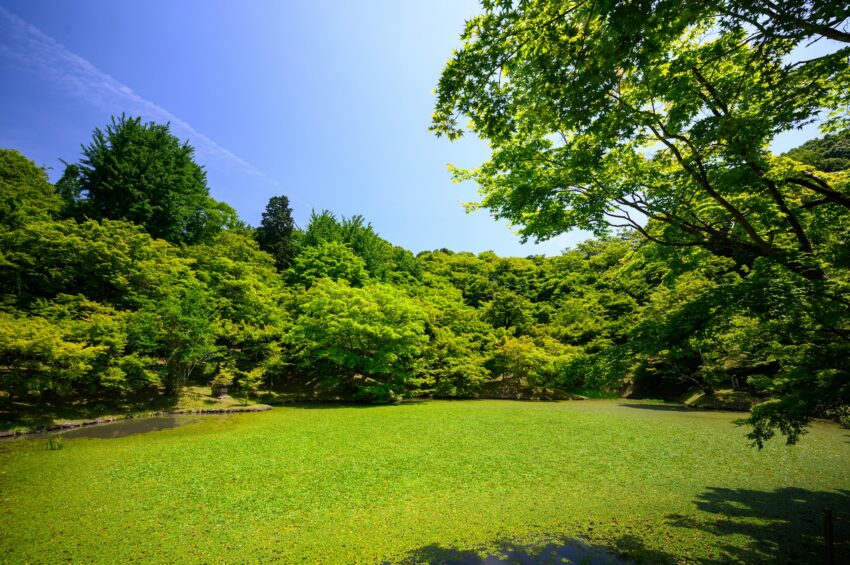A lush, green lawn is a classic symbol of the American dream. It’s where kids play, barbecues happen, and memories are made. But traditional lawn care practices can be surprisingly harmful to the environment. From guzzling water to polluting waterways with chemical runoff, our quest for the perfect lawn often comes at a cost.
The good news is that you don’t have to sacrifice a beautiful yard to be environmentally conscious. With a few simple changes, you can cultivate a healthy lawn that’s both pleasing to the eye and gentle on the planet. Here’s how:
1. Rethink Your Lawn:
- Embrace Diversity: A monoculture lawn—one type of grass covering a large area—is more susceptible to pests and diseases, requiring more chemical intervention. Consider incorporating clover or other low-growing, drought-tolerant ground covers into your lawn. These plants naturally fix nitrogen in the soil, reducing the need for fertilizers.
- Shrink Your Lawn: Do you really need all that grass? Consider reducing the size of your lawn by adding garden beds, planting trees, or creating a rock garden. This not only reduces maintenance but also creates a more diverse and visually interesting landscape.
- Go Native: Opt for native grasses that are adapted to your local climate. They require less water, fertilizer, and pesticides, and provide habitat for local wildlife.
2. Water Wisely:
- Water Deeply and Less Often: Encourage deep root growth by watering deeply but infrequently. This helps the grass become more drought-tolerant.
- Time it Right: Water early in the morning to minimize evaporation. Avoid watering in the heat of the day or late at night, as this can promote fungal growth.
- Harvest Rainwater: Install a rain barrel to collect rainwater from your roof. This provides a free, sustainable source of water for your lawn and garden.
- Adjust Your Irrigation: Make sure your sprinklers are watering your lawn, not your sidewalk or driveway. Consider installing a smart irrigation system that adjusts watering based on weather conditions and soil moisture.
3. Ditch the Chemicals:
- Test Your Soil: A soil test will tell you what nutrients your lawn needs, preventing over-fertilization.
- Go Organic: Use organic fertilizers, such as compost or manure, which release nutrients slowly and improve soil health.
- Say No to Pesticides: Most lawn pests can be controlled with natural methods like beneficial insects, nematodes, or even just a strong spray of water.
- Embrace Imperfection: A few weeds won’t hurt your lawn, and they can even provide food and habitat for pollinators. Learn to tolerate a few imperfections in your quest for a perfect lawn.
4. Mow Better:
- Raise the Blade: Mowing high (around 3 inches) shades the soil, reducing weed growth and water evaporation.
- Leave the Clippings: Grass clippings decompose quickly, returning valuable nutrients to the soil. This is known as “grasscycling” and can reduce your need for fertilizer.
- Sharpen Your Blades: Sharp mower blades make clean cuts, reducing stress on the grass and making it less susceptible to disease.
5. Aerate and Overseed:
- Aerate Annually: Aerating your lawn creates holes in the soil, allowing water, air, and nutrients to reach the roots.
- Overseed in the Fall: Overseeding helps thicken your lawn, crowding out weeds and improving its overall health.
Creating Your Backyard Escape
Now that you have a healthy, environmentally-friendly lawn, it’s time to create your backyard oasis. Here are a few ideas:
- Plant Native Trees and Shrubs: Trees and shrubs provide shade, privacy, and habitat for wildlife. Choose native species that are adapted to your local climate.
- Add a Water Feature: The sound of running water is incredibly soothing. Consider adding a small pond, fountain, or birdbath to your backyard.
- Create a Seating Area: A comfortable seating area is essential for enjoying your backyard. Choose furniture made from sustainable materials like recycled plastic or bamboo.
- Grow Your Own Food: Even a small vegetable garden or herb garden can provide fresh, healthy produce for your family.
- Invite Wildlife: Plant flowers that attract pollinators like bees and butterflies. Add a bird feeder or birdhouse to attract feathered friends.
By following these tips, you can create a beautiful, sustainable lawn that’s good for the environment and provides a relaxing retreat for you and your family. Remember, a healthy lawn is not just about aesthetics; it’s about creating a thriving ecosystem that benefits both people and the planet.
In addition to the benefits mentioned above, a sustainable lawn can also help to reduce stormwater runoff, improve air quality, and provide habitat for pollinators. By choosing native plants, using organic fertilizers, and reducing your water consumption, you can make a significant impact on the environment.
A sustainable lawn is also a great way to teach your children about the importance of environmental stewardship. By working together to create a beautiful, healthy lawn, you can instill a lifelong appreciation for nature in your children.
So what are you waiting for? Start making small changes today and create a sustainable lawn that you can be proud of. Remember, every little bit counts.
Additional Resources:
- The Environmental Protection Agency (EPA): https://www.epa.gov/
- Your Local Cooperative Extension Office: They can provide information on native plants, soil testing, and sustainable lawn care practices specific to your area.
Let’s work together to create greener lawns and a greener planet!


